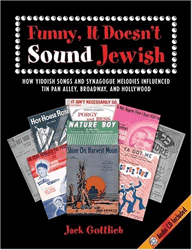Albany, N.Y.: State University of New York in association with The Library of Congress. c 2004
xxi, 306 p. : ill.; 30 cm. + 1 sound disc (digital; 4 3/4 in.)
Includes bibliographical references (p. 267-276) and indexes.
ISBN: 0844411302

Jack Gottlieb’s mission is to set the record straight. He wishes to clearly demonstrate through musical examples and technical musical means, that in fact, Jewish music from Yiddish song to synagogue melos, influenced American popular culture. This book could be a coffee table book, but it’s more. It could be the written record of years of Gottlieb’s programmatic material, but it’s more than that. Or, it could be the text of a course on Jewish influences on popular song, but it’s not quite that. It can be used as a broad reference work, and also has many elements of that. The book defies a neat categorization in terms of style, format and content, but has elements of each: an extensive, fascinating browse book, a music record with technical references, and a reference book with listings of hundreds of musical composers, lyricists, and songs of Jewish origin. The book is also political: it attempts to dispel the canard that Jews merely took advantage or exploited African Americans, but rather shows that a true cultural exchange with mutual benefits and influences existed between the two minority groups.
Gottlieb claims, that from that time to this, Jewish music has been inextricably linked to American music and vice versa. But exactly how? That is what this book lays out, in copious musical examples with score, diagram and theoretical explanations. Now, not every single example was as compelling or convincing as the others. There were some musical connections that seemed somewhat thin, but the majority of the examples seem to demonstrate the various points he makes. Those who do not wish to sit and follow the details of each and every musical example, (although this writer did), may read through the text and listen to the accompanying CD and get the general effect of the musical argument. Indeed, many people may wish to read the book in order to know whether their favorite show tunes came from a Yiddish song or synagogue music! The book is not a history. It is arranged by organizing principles of language and various compositional methods or techniques for using Jewish musical elements, and as such, is somewhat disjointed or pointillistic at times. One jumps from example to example without much sense of the historical continuity. One reason for that may be that so many of the various ideas were happening concurrently.
Whether or not one agrees that each and every example of Jewish influence on a popular song is compelling, the evidence in total suggests that Gottlieb has won his thesis. Yes, many composers, especially Jewish ones, brought in elements of songs they knew or heard, consciously or unconsciously, onto the American scene through their popular songs written in Tin Pan Alley or for Broadway, and later for movie scores. For some reason, one would presume this isn’t a big revelation on the face of it. Many composers of other ethnic minorities did the same thing. One could easily say that Italian, Irish, English or French immigrants brought with them music from their European backgrounds and used it in America when writing music. It seems logical that the Jews would do the same, and had their fair share of cultural contributions. And so they did. The difference is, as Gottlieb realizes, unfortunately, it is currently very popular among some, to deny Jewish artistic contributions as either very little, light weight, or non-existent. In regard to whether he proved that point that Jewish contributions were present, the evidence is overwhelming. In regard to whether these influences were substantial or significant in the total output of American popular song, is another question.
One could argue the reverse of Gottlieb’s thesis. For example, if it’s shown that Irving Berlin had even a few dozen songs influenced (or lifted) from Jewish sources, is that significant for a man who wrote over 800 songs? If Ira and George Gershwin had several pieces that were Jewishly influenced, they also had influences from African Americans. If a Arlen had songs reminescent of Jewish song, he also wrote mainly in a mainstream idiom. This book proves important contributions, but percentages or numbers are not the issue. Gottlieb’s point is that proving ‘substantial’ contribution is a matter of perspective. He shows that anyone who wants to understand the origins and early history of American musical theater or 20th century American popular song, now needs to be able to recognize these Jewish influences along with those of the other groups. They are all part of the whole and must be included. (not to mention that so many of the composers of early Tin Pan Alley, Broadway and movies themselves were Jews.) Gottlieb is not leading a cheer or pep rally, or merely stating “ain’t-we-great-because-there-were-so-many-Jews-who-did-this”. He’s looking at this body of music not only from the sociological or historical point of view, but from the inside out– from the linguistic and compositional views. He starts with the Yiddish language itself which Jews brought to America from Eastern Europe by the waves of mass migration at the turn of the 20th century. He shows how even the Jewish language greatly influenced, was part of, and forwarded the progress of song in America. Change to popular song in America started with the Yiddish language, and progressed from there through the genuis of some our greatest American songwriters and composers who had the Jewish musical “taam” (taste) and sound in their ear.
This book can also be used for sheer fun, a kind of aural “who dunnit” game and a wonderful puzzler. Gottlieb also is a self proclaimed punner, and the book is full of good humor, Yiddishkeit, and entertaining anecdotes. A lot of people, even those unfamiliar with Yiddish, will derive tremendous delight and “get a kick” going through the songs, hearing the various songs of origin, and hearing the CD where the examples clearly outline some of the more easily recognizable Yiddish or synagogue tunes turned into or transformed into a popular song. Another interesting sidelight were some of the ironic anecdotes. For example, everyone knows how tightly Irving Berlin guarded his copyright on his music– yet he apparently didn’t seem to mind lifting music from others, including Yiddish theater composer Goldfaden.
Besides his demonstrated prodigious musical memory and keen ear, Gottlieb’s scholarship makes the book a handy reference work. Appendix A lists composer, authors, and perfomers alphbetically, with birth date, place, and death date and place. It gives Jewish and stage or changed American names. Appendix B lists, by time period, “Yinglish” (mixture of Yiddish and English) songs titles. Appendix C gives musical examples titles. This information on Jewish-American’s song is not organized nearly this thoroughly in any other book, to my knowledge. The bibliography (p. 267-276) is extensive (and very worthwhile for students of American music or librarians). The CD tracks and texts are listed in the book, as well as an index. In addition to all this, the CD has fascinating clips of rare recordings by legends of the stage, radio and film.
This book is highly recommended for college, conservatory and university libraries and would also make a good gift for your friend who is a popular song or Broadway buff.
January 1, 2006
